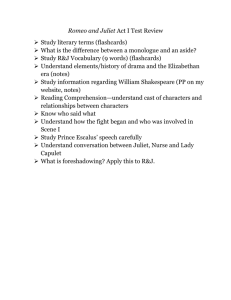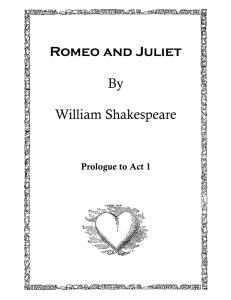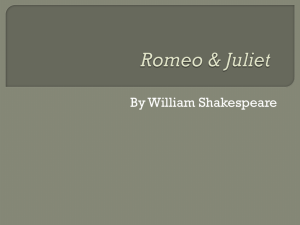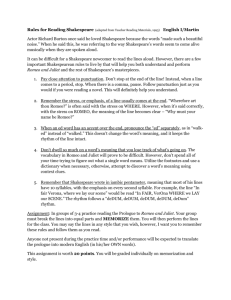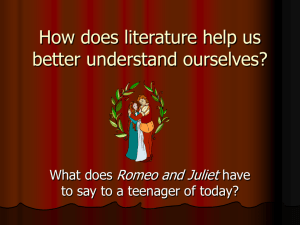Romeo & Juliet
advertisement
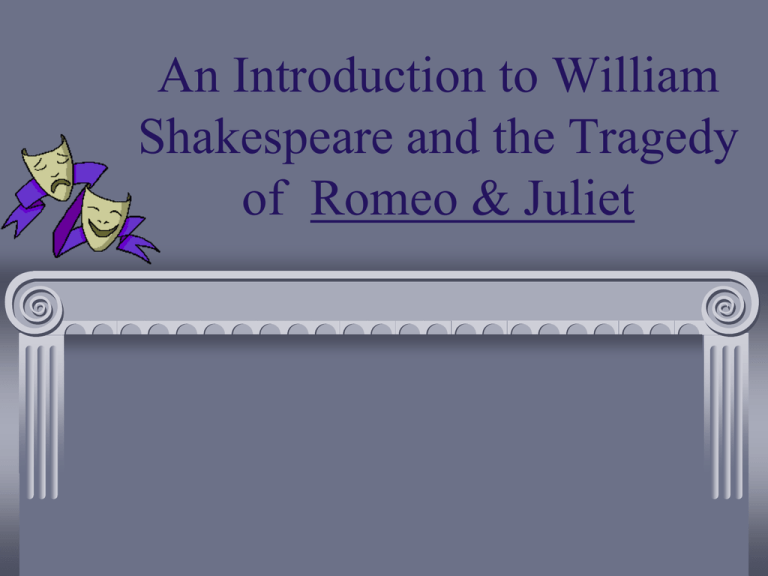
An Introduction to William Shakespeare and the Tragedy of Romeo & Juliet What we’re doing… informing ourselves about the life and work of the mysterious William Shakespeare. Providing ourselves with details about Elizabethan society and theater. Getting familiar with basic terminology related to Shakespearean drama. Why we’re doing it… This play can still be understood without knowing the “background” stuff, but it’ll make your understanding all the richer April 23, 1564: William Shakespeare was born in Stratford-on-Avon to John and Mary Shakespeare. There is a baptismal registration for Shakespeare, but few other written records exist. He was the 3 rd of 8 children. Much of Shakespeare’s younger years remain a mystery, but there are rumors about what jobs he may have worked. Schoolmaster Lawyer Lawyer Butcher Apprentice 1582: According to church records, Shakespeare married Anne Hathaway. At the time of their marriage, William was eighteen and Anne was twenty-six. *She wasn’t THIS old, but in this time period, to be unmarried past 20 or so as a lady meant you were seen as an “old maid.” Women were married much younger then. Marriage = the only way to have protection, (some) wealth, and (some) power in this society. Still, as a young woman, you were considered first property of your father, then property of your husband when you married. Fun, yes? William and Anne have three children together (Susanna, Hamnet, and Judith). August 1596: young Hamnet died at the age of eleven. The cause of his death is unknown, but it wasn’t uncommon for people to die suddenly of unknown illnesses (not a lot of medical knowledge at this time.) Shakespeare left his family in 1591 to pursue writing in London. Susanna Judith Hamnet A few more words about medicine at this time… Doctors usually didn’t train specially to become doctors. As a doctor, you’d probably learn some basic knowledge of herbs for healing, but you also probably had other jobs (fixing stuff, being a priest, being a lawyer, etc.) Friar Lawrence is this person in Romeo & Juliet. He’s a priest, but he dabbles in herbs and heals people who wouldn’t be able to afford a (slightly) better-trained doctor. A few more words about medicine at this time… One of the dominating medical beliefs at the time = “the four humours”. The theory that every person had a mix of fluids in their body; the one fluid they had the most of determined their personality. WHICH ONE ARE YOU? “sanguine” = more blood = cheerful, playful “choleric” = more yellow bile = restless, easily angered “melancholic” = more black bile = serious, more easily depressed, quiet “phlegmatic” = more phlegm = calm, thoughtful, peaceful A few more words about medicine at this time… If you were feeling ill, your “doctor” might figure out which “humour” seemed to be dominating you at that point, and give you a treatment designed to balance you out. Not sanguine enough? Have some wine! Because wine is like blood, right? (images of what people with each of the humours were thought to look like…) In 1592, Shakespeare began developing a reputation as an actor and playwright. As theatres were beginning to grow in popularity, it is probable that Shakespeare began earning a living writing plays (adapting old ones and working with others on new ones). 1594: William became involved with a company of actors named “The Lord Chamberlain’s Men.” This group later (1603) changed their name to “The King’s Men”. In 1598, Shakespeare, in collaboration with other actors, designed and built The Globe. This circular theatre was the first of its kind, breaking away from the traditional rectangular theatres. 1612: Shakespeare moved back to Stratford where he retired both rich and famous. 1616: William Shakespeare dies on his birthday. At the time of his death, Shakespeare is said to have written around 37 plays and 154 sonnets. He is also known to have contributed over two thousand words to the English language. Swagger* *yes, really! Visiting Shakespeare’s Grave… Good frend for Jesus sake forbeare To digg the dust encloasedheare Bleste be ye man [that] spares thes stones And curst be he that moves my bones. Which do you prefer? 1 2 3 Or….. Shakespearean Theater “The Globe” Romeo, Romeo… Wherefore art thou Romeo? Elizabethan Theatre Fun Facts The Globe Round/polygonal building with a roofless courtyard No artificial light – all plays performed during the day and day/night were suggested by scenery and lines in the play Three stories high – upper levels were for the wealthy The “groundlings” paid a penny a piece to stand on the floor in front of the stage (room for 800 people) Large platform stage that led right up to the audience Performance Fun Facts Elaborate costumes but only simple props and simple scenery No women allowed onstage (it was considered improper and kind of a promiscuous activity for a woman!) So….young boys played the parts of women. Yes, really! Many “all woman” versions of Shakespeare’s plays are performed in today’s world, to flip this expectation around. We’ll do it the same way in our class! Boys and girls will be able to perform both male AND female parts. Fire and Rediscovery Shakespeare’s Globe burned down, but its foundation was discovered in 1990. It gave us many clues to the Elizabethan experience such as hazelnut shells on the floors! A replica has since been rebuilt. You can visit it and see a play today. Dramatic Terminology Tragedy: A narrative about serious and important actions that end unhappily, usually with the death of the main characters. The play is broken up into acts and the acts are broken up into scenes. (Romeo & Juliet has 5 Acts; this is pretty typical for Shakespeare.) Monologue: A long uninterrupted speech given by one character onstage to everyone. Soliloquy: A long uninterrupted speech given by one character alone on stage, inaudible to other characters Aside: A short speech given by one character, traditionally the other characters cannot hear but the audience can. Dramatic Terminology Pun: A humorous play on words After that poisonous snake struck at me in the Arizona Desert, I was really rattled. A gossip is someone with a great sense of rumor. A carpenter must have been here. I saw dust. Energizer Bunny arrested - charged with battery. Corduroy pillows are making headlines across the nation. The executioner decided to drop out of Executioner School. It was just too cutthroat for him. Dramatic Terminology Dramatic Foil: A pair of characters who are opposite in many ways and highlight or exaggerate each other’s differences. Shakespeare’s 5 Part Storytelling Pattern (Tragedies): Act III: Crisis/Turning Point Even MORE complications Act II: Rising Action A series of complications Act I: Exposition Establishes setting, characters, conflict, and background Act IV: Falling Action Results of the turning point; characters locked into deeper disaster Act V: Climax/Resolution/Denouement Death of the main characters and then the loose parts of the plot are tied up 4/27 OR 4/28: 9.1 Love Problem Formulation Your first goal in today’s journal is to generate a list of problems you see in our society that deal with the following topics (by themselves or in any combination): Love lust teenagers adults parents family friends conflict time independence choice obedience hormones experience heartbreak rebellion You may write these problems as a list of complete sentences (A problem I see is……) or as more of a free-form paragraph - whatever 4/27 OR 4/28: 9.1 Love Problem Formulation Share this list of problems with your journal partner(s). Put a star next to any problems that you have in common with them. 4/27 OR 4/28: 9.1 Love Problem Formulation You know the drill!! With your journal partners, turn these problems into questions. Try to narrow it down to 3 really strong, nosingle-right-answer, opinion-based questions. Write at least one really solid question on your index card; I’ll collect shortly. 4/27 OR 4/28: 9.1 Love Problem Formulation (cont’d) How do other writers besides Shakespeare grapple with some of the problems and questions you generated?.... ….let’s compare two examples. 4/27 OR 4/28: 9.1 Love Problem Formulation (cont’d) Partner A + Partner B. Group of 3? Two Partner As. Partner A is in charge of “To the Virgins…” by Robert Herrick; Partner B is in charge of “24 Hours” by Sky Ferreira Listen + annotate your assigned text for details that stand out 4/27 OR 4/28: 9.1 Love Problem Formulation Share your initial annotations, but NOT with your journal partner. Partner up with the next-nearest journal partnership, and talk to the person in that partnership that annotated the same text as you. Try to come to some shared understanding of what’s going on in your text, even if you’re not 100% sure you “get” it. 4/27 OR 4/28: 9.1 Love Problem Formulation In your journal, write for a few minutes under today’s entry space: What seems to be basically going on in your poem? What argument(s) about love does the speaker make? What details led you there? Do you agree with the argument he or she is making? Do you think their view of love is correct? Why or why not? 4/27 OR 4/28: 9.1 Love Problem Formulation Compare your findings with your partner – teach them the main idea(s) behind your poem, the speaker’s main argument(s) about love, and whether or not you and the speaker see things the same way 4/27 OR 4/28: 9.1 Love Problem Formulation Final recap: Briefly compare both poets’ views on love as shared by you and your partner. How are they the same? How are they different? Tips for Understanding Romeo and Juliet Romeo and Juliet is based on Arthur Brooke’s long narrative poem the Tragicall Historye of Romeus and Juliet (1562) Be ready for independent reading right at the start of class today! (We need to have time for our competition.) CY 28 will be saved for later OR the next time we meet. Gold stamp sheet out, label a square for independent reading 4/29, find your log. MONTAGUE Romeo Lord Montague (his dad) Lady Montague (his mom) Mercutio (friend) Benvolio (cousin) vs. CAPULET Juliet Lord Capulet (her father) Lady Capulet (her mother) Tybalt (cousin) Nurse To get in the mood for a feud… Competition time! What we’re doing: practicing breaking down tricky Shakespearean language Why we’re doing it: this will equip you for when we start reading/performing on Thursday/Friday Prologue Scramble Make a group of 2-4 people. (Period 2 – go for closer to 4) Receive an envelope from Ms. Zero. Your goal: Work as a group to put the lines of the prologue in correct order. Ms. Zero will walk around, giving you four hints along the way. Free hint #0: Look at end punctuation! NO CHEATING! Keep each other honest. Use your knowledge of poetic forms to help you. When you think you’re ready, raise hands so I can check you. Top two teams win a free homework pass AND recognition on the Board of Champions!!! When finished: Receive a translation sheet from Ms. Zero. Translate the prologue from Elizabethan English to more easily read, modernized English. Don’t know a word? Check with your group members and/or dictionaries. Take a look at the context for meaning, too. Copy your finalized translation on the back of your sheet and be ready to share it.
